 Lauren Allen is a miracle
Lauren Allen is a miracle
I was born Feb 22, 1995, with some heart defects. The main defect is called (TGA)Transposition of the Greater Arteries. I also have 2 other heart defects: VSD, Ventricular Septal Defect, and ASD, Atrial Septal Defect. See more explanations below.
Lauren had several heart surgeries since she was born.
On February 23, 1995, I had my first surgery. On July 22, 1997, I had Open Heart Surgery to correct all of my heart defects. I have also had a pacemaker replacement and a couple of pulmonary artery replacement surgeries. See the journey of my wonderful life below.
What is the (TGA) Transposition of the Greater Arteries?

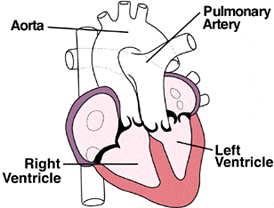
Normal Transposition
In this situation, the pulmonary arteries are supplied by the left ventricle, and the aorta by the right ventricle.
This, of course, is the opposite of the normal arrangement. Infants can only survive if there is a shunt between the two sides of the heart, and an atrial septal defect needs to be actually enlarged to allow adequate mixing of blood to deliver enough oxygenated blood to the body. Significant advances have been made in the surgical treatment of this disorder.
ŠCOPY: 1997 HeartPoint Updated November 1997
What is an Atrial Septal Defect?
This defect is characterized by incomplete closure between the two upper chambers of the heart. Blood can therefore flow through a hole (defect) in the wall (septum) between the upper chambers of the heart (atria) from one side to the other, causing some heart chambers to have to pump extra blood. The heart can dilate, the muscle can become weak, and the pressures in the pulmonary arteries can increase (pulmonary hypertension) due to the increase in blood flow. If the defect closes on its own or with the aid of surgery, these consequences can be avoided.
This defect may vary in size
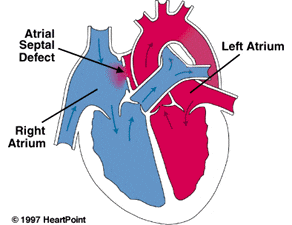 Blood flows mainly from the higher-pressure left side to the right, although there is a little blood that crosses the other way. The defects may be of different sizes, and some may be associated with other abnormalities. Both of these factors determine whether and what type of surgery may be necessary. If a substantial size defect is not corrected, then the pressures in the pulmonary arteries may become very high and induce changes in the arteries themselves such that even closure of the defect will no longer improve the patient. In this case, the pressures in the right side of the heart are high enough that blood may begin to flow from the right to the left side of the heart. This situation is called “Eisenmenger’s syndrome”, a condition that may result from several similar abnormalities.
Blood flows mainly from the higher-pressure left side to the right, although there is a little blood that crosses the other way. The defects may be of different sizes, and some may be associated with other abnormalities. Both of these factors determine whether and what type of surgery may be necessary. If a substantial size defect is not corrected, then the pressures in the pulmonary arteries may become very high and induce changes in the arteries themselves such that even closure of the defect will no longer improve the patient. In this case, the pressures in the right side of the heart are high enough that blood may begin to flow from the right to the left side of the heart. This situation is called “Eisenmenger’s syndrome”, a condition that may result from several similar abnormalities.
ŠCOPY:1997 HeartPoint Updated November 1997
What is a Ventricular Septal Defect?
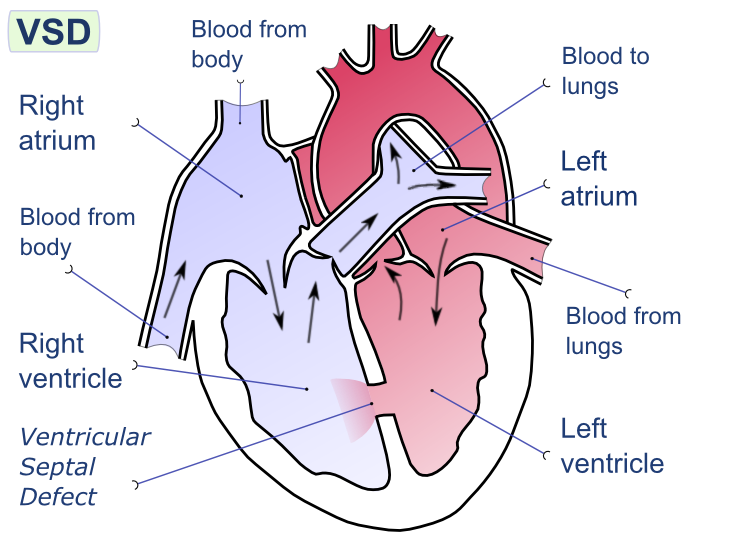 This defect is very similar to atrial septal defects. In this case, the hole or “defect” is in the heart muscle forming a wall between the ventricles (the intraventricular “septum”). As in the case of ASD, the heart can dilate, the muscle can become weak, and the pressures in the pulmonary arteries can increase (pulmonary hypertension) due to the increase in blood flow. If the defect is closed, these consequences can be avoided.
This defect is very similar to atrial septal defects. In this case, the hole or “defect” is in the heart muscle forming a wall between the ventricles (the intraventricular “septum”). As in the case of ASD, the heart can dilate, the muscle can become weak, and the pressures in the pulmonary arteries can increase (pulmonary hypertension) due to the increase in blood flow. If the defect is closed, these consequences can be avoided.
Like ASD, the size and therefore the clinical course of these defects is quite variable.
Some remain large, while others become smaller over time. It is not unusual for small-to-medium-sized VSDs to eventually close spontaneously. Many, but not all that remains will require surgery. If a substantial size defect is not corrected, then the pressures in the pulmonary arteries may become very high and induce changes in the arteries themselves such that even closure of the defect will no longer improve the patient. In this case, the pressures in the right side of the heart are high enough that blood may begin to flow from the right to the left side of the heart. This situation is called “Eisenmenger’s syndrome”, a condition that may result from several similar abnormalities. ŠCOPY:1997 HeartPoint Updated November 1997
Pacemakers Save Lives
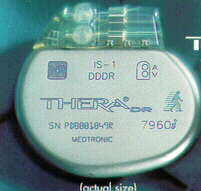
This is a picture of the pacemaker installed, initially when I was 2 1/2 years old. It was made by Medtronics The model number is DR 7960i. It is a dual-chamber pacemaker with 2 pacing leads, one in the atrium, and one in the ventricle. This pacemaker has a sensor that detects changes in my activity level and then adjusts my heart rate accordingly. My doctor can program the activity sensor “on” or “off” depending on the pacing therapy most suitable
for my condition.
NIKAIDOH procedure (Aortic translocation)
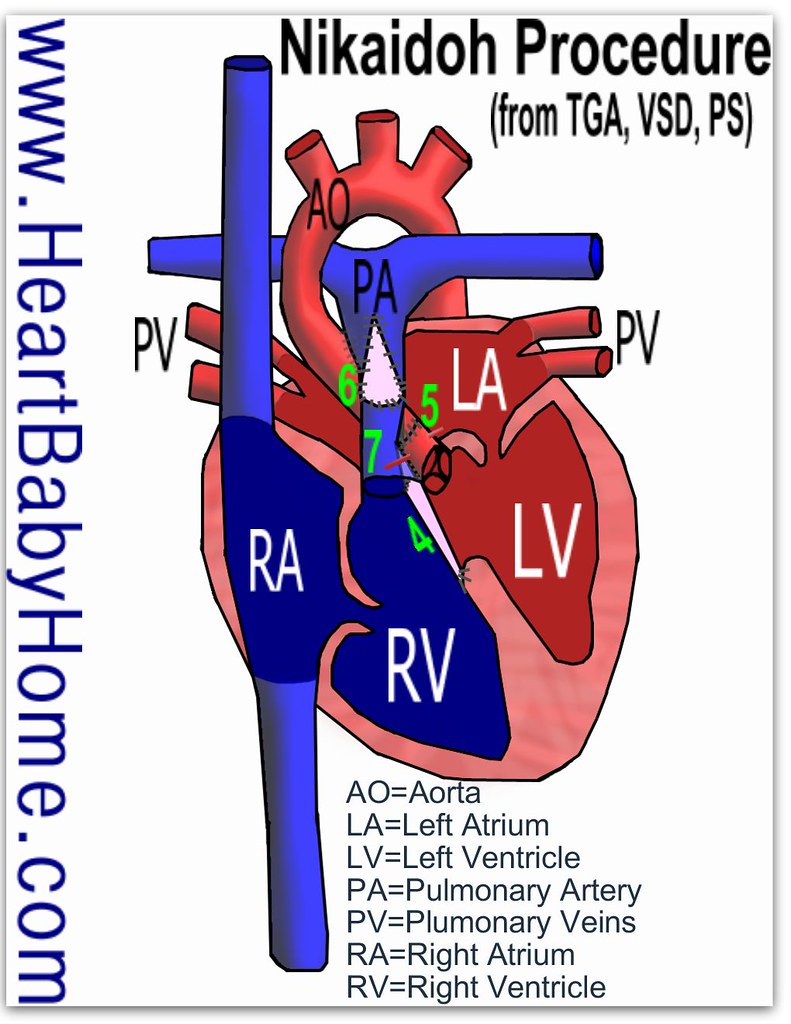 In this operation, the aorta is “switched” ALONG WITH THE AORTIC VALVE and placed in the pulmonary position. This avoids a leak of a faulty pulmonary valve on the left side. An operation described in the setting of double outlet right ventricle or transposition with pulmonary stenosis, including pulmonary annular hypoplasia, is aortic translocation with the reconstruction of the right ventricular outflow tract[54]. The aortic root, including the aortic valve, is excised from the right ventricular outflow tract in a manner analogous to that applied for the pulmonary autograft operation.
In this operation, the aorta is “switched” ALONG WITH THE AORTIC VALVE and placed in the pulmonary position. This avoids a leak of a faulty pulmonary valve on the left side. An operation described in the setting of double outlet right ventricle or transposition with pulmonary stenosis, including pulmonary annular hypoplasia, is aortic translocation with the reconstruction of the right ventricular outflow tract[54]. The aortic root, including the aortic valve, is excised from the right ventricular outflow tract in a manner analogous to that applied for the pulmonary autograft operation.
In addition, it is necessary to mobilize the coronary arteries, as is done for an arterial switch procedure. The pulmonary root is divided at the level of the pulmonary valve, which is excised. The outlet septum is excised, thereby removing the superior margin of the ventricular septal defect. The aortic root is translocated posteriorly so that it lies primarily over the left ventricle. The ventricular septal defect is closed with a patch, which is anchored to the aortic root at its superior margin.
The pulmonary artery is connected to the right ventriculotomy with an anterior patch of the pericardium. No large series using this procedure have been reported, so its practicability remains to be determined. Nevertheless, with increasing experience with the arterial switch and the pulmonary autograft aortic root operations, the necessary steps will be familiar to surgeons who contemplate using this innovative procedure.
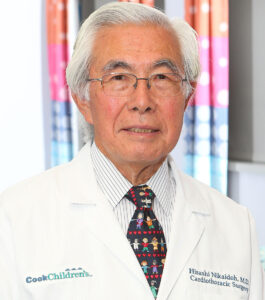 Dr. Hisashi Nikaidoh
Dr. Hisashi Nikaidoh
E-mail: hnikai@childmed.dallas.tx.us
Mail: 1935 Motor Street
Dallas, TX 75235
Phone: 1 214 640-7280
Fax: 1 214 640-7284
Informative links
Here are some links that are related to this subject and better explain some of the terminologies of cardiac heart disease.
- Medtronics Pacemakers
- Congenital Heart Defect Support Group
- Conquering CHD – Congenital Heart Information
- Adult Congenital Heart Association
- The American Heart Association
- Camp with Heart – Camp ODayin – Camp for Children with Heart Disease
‘Click Here for Lauren’s Update!‘



Disclaimer! – I am not a Doctor.
 The information is not to be used as a medical diagnosis or to replace a Doctors consultation. The content provided here is meant for general educational purposes only and is not intended as a substitute for consultation with your physician or other healthcare professionals.
The information is not to be used as a medical diagnosis or to replace a Doctors consultation. The content provided here is meant for general educational purposes only and is not intended as a substitute for consultation with your physician or other healthcare professionals.
The information presented is not intended as medical advice.
 Lauren Allen is a miracle
Lauren Allen is a miracle